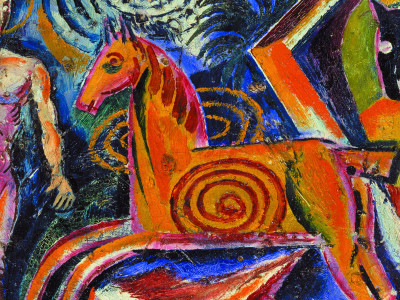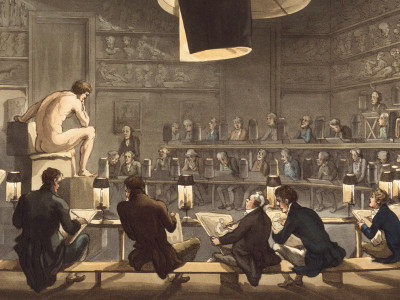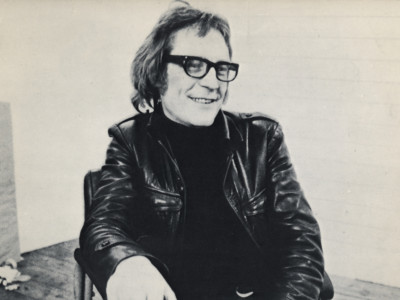
10 art exhibitions to see in November
By Rebecca Reading
Published on 1 November 2018
This month see art that spans a millennium. From the 11th-century Domesday Book, to Japanese surimono prints and empty swimming pools, here are 10 exhibitions to check out this November.
Roman Vishniac Rediscovered
The Photographers' Gallery and the Jewish Museum London, London, 26 October 2018 – 24 February 2019
This is the first UK retrospective of photographer Roman Vishniac – and photography super-fans will enjoy the chance to see it twice; it's on at both the Photographers' Gallery, and the Jewish Museum, with each exhibition showing different works, but sharing the same narrative.
The Russian-born American photographer emigrated from Moscow to Berlin in 1920 following the Bolshevik Revolution, and his own work as a photographer coincided with the disturbing political changes – oppression, propaganda and the rise of Nazism – throughout Eastern Europe. In 1935, Vishniac was commissioned by the American Jewish Joint Distribution Committee (JDC) to document impoverished Jewish communities; at the end of the war and in the wake of the Holocaust, these images became, as the exhibition's curator writes, "the most comprehensive photographic record by a single photographer of a vanished world". Social and political documentation continued to be a focal point when Vishniac moved to New York in 1940. In the US, he recorded the impact of the Second World War on Jewish refugees and Holocaust survivors, as well as immigrant communities including Chinese Americans.
Across the two parts, this exhibition brings together the prolific and varied output of Vishniac's photography, exploring his work as one of the most important documentarians of the 20th century, as well as his later scientific research as a professor of biology and art.

Andy Warhol and Eduardo Paolozzi | I want to be a machine
Scottish National Gallery of Modern Art, Edinburgh, 17 November 2018 – 2 June 2019
"I want to be a machine," Andy Warhol famously declared. What may have at first seemed like standard drollness uttered by the founder of the Factory was actually a prediction that in the future art would increasingly become more mechanised. The Scottish Gallery of Modern Art takes this theme to explore the work of Warhol and Eduardo Paolozzi, charting their development on either side of the Atlantic. The show demonstrates how both artists captured images from photography and advertisements – Warhol traced while Paolozzi used collage – before turning to screenprinting in the early 1960s. Highlights include rarely seen Warhol drawings from the 1950s, and Paolozzi's early proto-Pop collages.

Edward Burne-Jones
Tate Britain, London, 24 October 2018 – 24 February 2019
This is the first solo show at Tate since 1933 on Edward Burne-Jones, bringing together 150 works, including major paintings, stained glass, wall tapestries and drawings by the Pre-Raphaelite artist who looked to myths, legends and Arthurian romances to inform his work. Huge paintings, such as The Wheel of Fortune (1883) and Love among the Ruins (1870–73), adorn the walls of the gallery, accompanied by two rooms dedicated to the artist's famous narrative cycles, The Briar Rose (c. 1890) and the unfinished story of Perseus (begun in 1875). While the show explores the pivotal role of the decorative arts in Burne-Jones' career, including his long working relationship with William Morris, it also reveals the artist as a pioneer of the Symbolist movement, and promoter of an ambitious expression of a beauty that was both ethereal and overwhelmed by a sense of ennui.

Elmgreen & Dragset: This Is How We Bite Our Tongue
Whitechapel Gallery, London, 27 September 2018 – 13 January 2019
Working together since 1995, artist duo Michael Elmgreen and Ingar Dragset explore the relationship between art, architecture and design. For their survey exhibition This Is How We Bite Our Tongue the artists have transformed the ground floor of the gallery into an abandoned swimming pool, a deserted space relating to the gentrification of London's East End. The work is accompanied by a fictional narrative charting both the pool's rise as a public amenity and its politically sanctioned and commercially driven decline. Elmgreen & Dragset take influence from 19th-century Danish painter Vilhelm Hammershøi, who turned the domestic space into scenes of bourgeois psychological repression (and whom extra dedicated art-lovers may remember from a show at RA in 2008). This theme extends through work across the gallery, prompting an elegiac mood and concern for modern culture and politics.

Taylor Wessing photographic Portrait Prize 2018
The National Portrait Gallery, London, 18 October 2018 – 27 January 2019
Since 1993, the annual Taylor Wessing Photographic Portrait Prize has celebrated and promoted the best in contemporary portrait photography. This year's winner is London-based Alice Mann, who is the first photographer to win the prize for the series of portraits – hers documenting South African drumming majorettes from the Western Cape. Mann, who spent three months documenting the project, said she wanted to "create images that reflect the pride and confidence the girls achieve through identifying as 'drummies'". The winning series will be exhibited alongside other entries at the National Portrait Gallery.

Plum Blossom and Green Willow: Surimono Poetry Prints
Ashmolean, Oxford, 2 October 2018 – 17 March 2019
The Ashmolean gallery is currently displaying a number of 18th- and 19th-century woodblock surimono (printed objects) from its own collection alongside new acquisitions, offering a rare insight into Japanese literati culture. Surimono prints were privately published and circulated by wealthy patrons, often members of poetry societies. The works combined elegant pictures made by leading print designers alongside witty poems – mainly haikus or kyōka (playful verse). Surimono were not intended for public sale and instead catered to the tastes of their small, highly educated audience. This show presents a selection of surimono prints alongside picture calendars and illustrated stories.

Patrick Heron: His Painting Now
Turner Contemporary, Margate, 19 October 2018 – 6 January 2019
Turner Contemporary exhibits 50 years of Patrick Heron's giant colourful abstracts, spanning 1943–96. The exhibition explores the late RA's contribution to postwar abstraction and his preoccupation with colour. In 1962 Heron claimed that colour was both the "subject and the means; the form and the content; the image and the meaning, in my painting today". Heron's art is a visual sensation that directly responds to the light, colour and shape of everyday forms. In the galleries, Heron's work is displayed in a succession of spaces and juxtapositions, rather than chronologically, encouraging a new understanding of his creative processes. Standing in front of Heron's rich aesthetic vibrancy, we in turn participate in his own joyous act of looking.

Anglo-Saxon Kingdoms: Art, Word, War
The British Library, London, 19 October 2018 – 19 February 2019
The British Library presents 600 years and 180 treasures from its own collection for a once-in-a-generation exhibition. The world-famous Domesday Book – the most famous book in English history – will be featured alongside the illuminated Lindisfarne Gospels (698–721), Beowulf, Bede's Ecclesiastical History and finds from the Staffordshire Hoard. The exhibition details the beginnings of English language and literature, with some of the earliest inscriptions of the English word in records, Old English poetry and prose. See the enriched artistic connections between Anglo-Saxon England and its European neighbours, and the stories of the people in their own words – from the end of Roman rule in Britain to the Norman conquest of England.

Barry McGlashan – Line of Beauty
John Martin Gallery, London, 2 – 24 November 2018
Step into the (fictional) studios of Leonardo, Raphael, Rubens and Picasso, among others, as Barry McGlashan recreates the interiors of some of the world's most significant artists. With layer upon layer of intricate, thoughtful and comedic detail, McGlashan's paintings are musings on painting itself – how artists made their work, and the context in those works were made. The show includes preparatory drawings and studies by McGlashan as well as paintings, which build upon the artist's theme of "finding". McGlashan's storytelling traces a line through the history of art in the rooms where it all began.

Christina Rossetti: Vision & Verse
Watts Gallery, Artists' Village, 13 November 2018 – 17 March 2019
Born in 1830 into an intellectual Anglo-Italian family, the celebrated Victorian poet Christina Rossetti was the youngest of four children, who all had successful careers as writers and artists. This exhibition unites portraits of Rossetti (including two made by her brother, Dante Gabriel Rossetti) with works inspired by her words as well as the poet's own drawings, revealing Rossetti's connections to the art world and fervent interest in how her work was illustrated. The exhibition explores poet's collaborations with artists, through illustrations made by her brother Dante for Goblin Market (1862/65) and The Prince's Progress (1866), as well as Arthur Hughes and Frederick Sandys. While visiting, don't miss the red brick Watts Cemetery Chapel, a masterpiece of Arts & Crafts architecture.

Related articles

Visions from Ukraine
19 June 2024

10 RA Schools stories through the centuries
16 May 2024

In memoriam: Mick Moon RA
1 May 2024